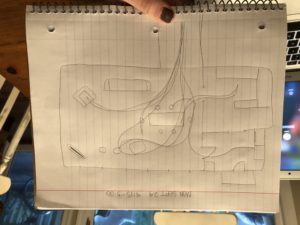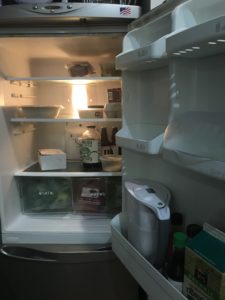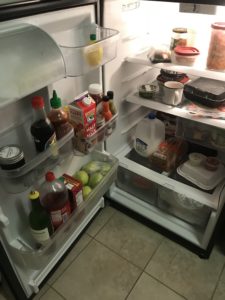During the observation period of the project, I conducted 2 separate types of observations. The first was a direct observation in which I sat in the common area of my house at 4:15 pm on a Monday for 30 minutes and recorded the movement throughout the space and the interactions among my housemates. I found drawing a map of space and drawing lines of where people moved was very helpful to see where the most traffic in the common spaces took place. This informed me of how my housemates used the space and how it reflected the nature of our relationships. For example, my housemate Lauren got back from a weekend out of state as I was observing and she immediately came through the door and plopped down on a chair in the living room and started talking to me and my other housemate. She ran upstairs for a minute and came back with a mirror and her makeup and told us she was going to do her makeup down there so she could be with us. This kind of interaction was helpful later in coming up with our behavioral research questions and drawing links between the use of common spaces – specifically whether they were public or private.

House Common Area Movement Map
At times I found the observation process difficult because I thought my notes and findings were obvious. For example, the second type of observation I conducted was an indirect one where my teammates and I asked various people who had recently moved to dense urban areas. We all asked for the same few photos:
- Inside your fridge
- Your kitchen right after cooking a meal
- The first thing you see when you wake up
- Your bathroom counter without cleaning it
- Your common area in use
- The first few steps into your apartment
We received photos back and at first, I found it difficult to draw findings from the photos. Especially because I was looking at my sisters’ apartment, and since we are so close I didn’t feel like I could really make any assumptions about her use of the apartment. I saw the picture of my sisters’ kitchen and didn’t draw any conclusions, but one of my teammates saw it was noticed for such a small kitchen there were a lot of coffee and tea appliances. Luckily, my team met and were able to take a look at the photos and draw some observations from them.
I found meeting together as a group and talking over our observations was very helpful. Together we were able to draw connections between what we were seeing in our indirect and direct observations. Because a few of our observations contradicted each other, the behaviors in each were enhanced. For example, Sarah created a movement map of the common area in her apartment building (shared by all tenants of the apartment complex), whereas I created a movement map of the common area in my house. The results were very different. We found that public common areas are not used when tenants are alone – they will not even wait downstairs and watch TV while their laundry is running, instead they will go up and downstairs every time they need to switch out their laundry. We found that private common areas are used when tenants are both alone and with other housemates.

Participant living without significant other

Participant living with significant other
The indirect observation was great in helping us come up with our behavioral research questions. Because we decided to ask multiple people living in dense urban areas with different relationship statuses and living situations we were able to get at some questions regarding behavior. We noticed that the one participant who was not living with a significant other had a very empty fridge with mostly takeout containers, while the other 2 participants were living with their significant others and had more condiments and ingredients in their fridges. We began to wonder if the takeout container suggested more socialization with non-housemates and how the relationship of housemates impacts the use of common areas. Another trend we noticed was the prevalence of tea and coffee paraphernalia, which we then wondered,are coffee and tea rituals important social behaviors?
Overall the observation period narrowed our focus by leading us towards behavioral research questions which we will adapt into making an interview guide.